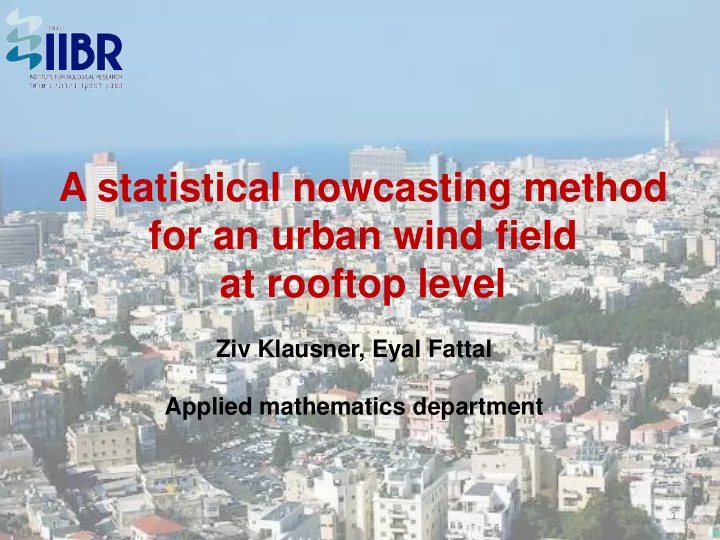

A statistical nowcasting method for an urban wind field at rooftop level Ziv Klausner, Eyal Fattal Applied mathematics department 1
Urban wind field: varying homogeneity 15-8-98 2100 15-8-98 0800 2
Ongoing network of weather stations Ideal Reality Therefore, our approach: – Define a distribution – Choose a representative sample – Nowcasting using statistical inference
Population ’s spatial distribution Define the wind vector, in time t , at a point (x, y) U t , x y as a random variable The population of wind vectors in time t : wind in all possible points (x, y) in a given area A U ; , F x y A P t x , y Parameters: • Expectancy (2D vector) t • Covariance (2x2 matrix) t 4
A sample of the spatial distribution Given the population, a representative sample can be chosen. It consists of n weather stations: F U , U , ..., U S t t t x , x x , x x , x 1 1 2 2 n n From it, the following statistics are calculated: u • spatial average t U t v t var u cov u v , • covariance matrix t t t S t cov u v , var v t t t These are estimators for and t t 5
Tolerance region In terms of repeated sampling, for the i -th sample: • R i - tolerance region constructed to assure: E[ p i ] = P • p i - actual proportion contained in R i We choose to use elliptic R t in u, v space: T 1 2 S U ; U U U U R D P t t t t t t t x , y x , y D 2 – Mahalanobis distance for P 6
D 2 (P) for the case of bivariate normal distribution For a population ( and are known): t t 2 2 1 , 2 D P P For a sample (around for E[ P ]): U t 1 2 n 1 n 1 F 1 P ; 2 , n 2 2 D P , n n n 2 Chew, Journal of American Statistical Association,1966 7
Application for the metropolitan area of Tel-Aviv Photographs by Yan Nasonov, Felix Rubinstein, Remi Jouan, EdoM, Paul Simpson, Cccc3333, 8 distributed under a CC-BY 2.0 license.
Stages 1. Choosing a sample 2. Sample’s representativeness examination 3. Tolerance region estimation: D 2 = f (E[ P ]) 9
Choosing a sample Available DB: • metropolitan Tel-Aviv • ~20 weather stations • rooftop level Based on meteorological considerations - entry of climatic phenomena to the area: • sea breeze • slope winds • weather fronts Therefore, weather stations on the area’s perimeter (“ fence ”) 10
Sample’s representativeness examination For each t we’ve calculated: u • t spatial average U t v t var u cov u v , • covariance matrix t t t S t cov u v , var v t t t For every U t we’ve calculated: T 2 1 S D U U U U U t t t t t t x , y x , y x x Once for and another for U F U F t P t S , y , y 11
Sample’s representativeness examination – D 2 distributions 12
Tolerance region: D 2 (E[P]) ─── D 2 =2.5, E[P] = 52% ─── D 2 =5.1, E[P] = 69% ─── D 2 =7.7, E[P] = 79% 13
Tolerance region: Empirical vs theoretical Winter Spring Summer Autumn 14
Learning: 2 months of each season R 2 = 0.9039 R 2 = 0.96086 0400 0800 1200 2100 15
Validation: on the remaining month 0400 0800 1200 2100 16
Discussion The model: • Inherent wind speed- direction correlation • Includes a distinct directionality ─── D 2 =2.5, E[P] = 52% ─── D 2 =5.1, E[P] = 69% ─── D 2 =7.7, E[P] = 79% 17
Summary • Wind field is represented by 4 perimeter stations • Nowcasting based on O/L measurements Advantages: • No need for further historical data • Relevant for all the area (rooftop level) • Speed-direction correlation, distinct directionality 18
19
Recommend
More recommend